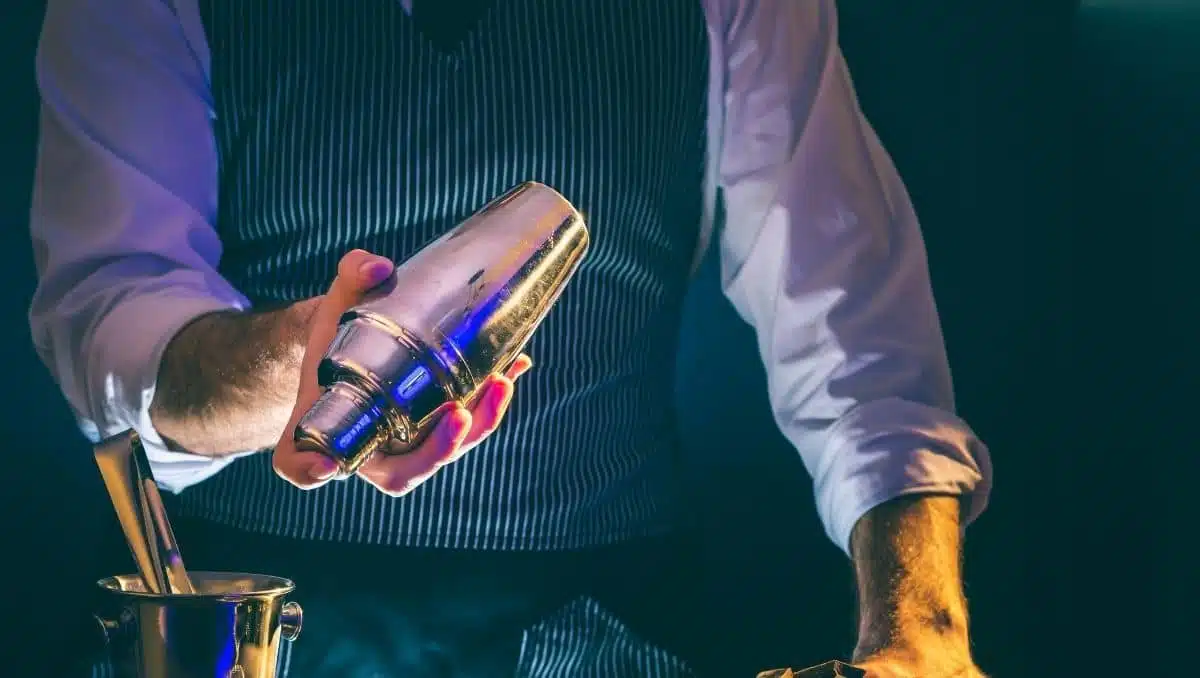A dry shake means shaking your cocktail at room temperature without adding ice. After vigorously shaking for at least 15 - 20 seconds, add ice and shake once more before pouring the drink.
Dry shaking helps to create a thicker and more robust egg white or aquafaba foam.
Follow These Steps to Dry Shake a Cocktail
The technique of dry shaking a cocktail is easy to master once you know the basic steps. Here's how to do it:
- Measure ingredients as usual and pour them into your cocktail shaker.
- Seal the shaker and shake the ingredients vigorously without ice for 15 to 20 seconds.
- Open the shaker to add ice cubes and seal it again.
- No shake as per usual for 8 to 12 seconds.
- Strain or double-strain the cocktail into the glass.
Pro Tips to Get The Perfect Foam
Dry shaking certainly helps to create better foam. However, it requires a bit of experience. Here are two pro tips to help you with that.
- Seal the shaker properly: Sealing a cocktail shaker is typically quite easy. The ice causes the metal to contract which helps to keep the seal tight. That doesn't happen in a dry shake, and as a result, I've seen exploding shakers during dry shaking more than once. So, ensure to seal the shaker extra tight.
- Use of the coil of your Hawthorne strainer: remove the spring of your bar strainer and put it into the shaker during the dry shake. The spring/coil helps to aerate the ingredients, creating a much more robust foam.
How to Perform a Reverse Dry Shake
Some prefer using a slightly different method for creating foams, the reverse dry shake. Reversing means that you first shake your cocktail with ice like you usually would. Then you remove the ice, which works best with a Tin or Boston shaker (you can also check out the different types of cocktail shakers).
- Add ingredients to your cocktail shaker and shake for 8 to 12 seconds.
- Open the shaker, have the contents in the larger tin, and strain them into the smaller one, leaving the ice in the big piece.
- Discard the ice and perform a dry shake for 10 to 15 seconds.
- Strain your drink into your cocktail glass.
The reason for changing the order is that the bulkiness of the ice cubes will reduce the mousse-like texture of the egg white and reduce its frothiness. In theory, that means you get better results with a reverse dry shake.
But honestly, it's a matter of preference. Some do better with the classic way of dry shaking, while others swear by the reverse version. Try both and decide for yourself which is best for you.
What is a Dry Shake?
Shaking a cocktail dry means that you shake it without ice before shaking it a second time with ice. This extra step helps to create a better and stronger foam in cocktails like the Whiskey Sour, Clover Club, or Gin Fizz.
Usually, you would put all ingredients - or rather those supposed to go into the shaker- together with the ice. Then you would shake for a few seconds until the contents are well-chilled, and that's it. Consequently, that is called a wet shake.
When to use it?
A dry shake always is required in recipes that include egg white or the vegan alternative, aquafaba. When shaken right, both of them will create a beautifully frothy, silky, white foam on top of your cocktail.
These eggwhite or aquafaba foams are usually part of Sour cocktails, such as Whiskey Sour, Rum Sour, Gin Sour, or Mezcal Sour.
In case you are concerned about using raw egg white, don't worry. That's why it's so popular with Sour drinks because the acid cooks the egg white just enough to get rid of bacteria.
What Happens When I Dry Shake?
Shaking a cocktail without ice facilitates emulsifying the egg white or the aquafaba. Leaving off the ice cubes also helps create the tiny air bubbles in the cocktail responsible for the nice frothy texture.
You can create foam with a wet shake only, but you will have to shake your cocktail a lot longer, and the foam still won't have that nice, firm, mousse-like texture.
The big, chunky ice cubes hurl around in your shaker so that not enough bubbles can build up. With a dry shake, your cocktail mixture can develop all those tiny froth bubbles, and we get a textbook-perfect Sour cocktail.
Dry Shake vs. Reverse Dry Shake
De facto, you usually get more foam with the reverse dry shake. Nonetheless, I 100% prefer the classic method: shake your drink dry first, perform a wet shake second. It's easy to do with all types of shakers, and the cocktail is ice cold at the time of pouring.
The reason is that I find the process just slightly more straightforward. That may not make much difference when mixing a cocktail at home. But behind the bar counter, every move counts.
Also, I find the amount of foam and its consistency better when applying the classic method. Especially when using the strainer coil results are superb.
Depending on the glassware, it's never less than 0.5 to 1 inch but not more than 2 inches. It's also firm enough to put your garnish or bitters on top. And that's precisely what I want.
More foam may look impressive but it's unpleasant when drinking your cocktail because you end up with a mouth full of egg white instead of half foam, half liquid. Plus, the bubbles often are so loose that they can't hold your garnish.
However, if, for some reason, you don't get the desired result with the classic method, try the reversed alternative.
FAQs
Final Note
A dry shake is an excellent way to create foamy cocktails. The additional step of shaking without ice helps to build up a thick and more robust foam you typically won't achieve with a classic wet shake.
For best results, use the coil of your cocktail strainer while dry shaking to aerate the ingredients even better.

